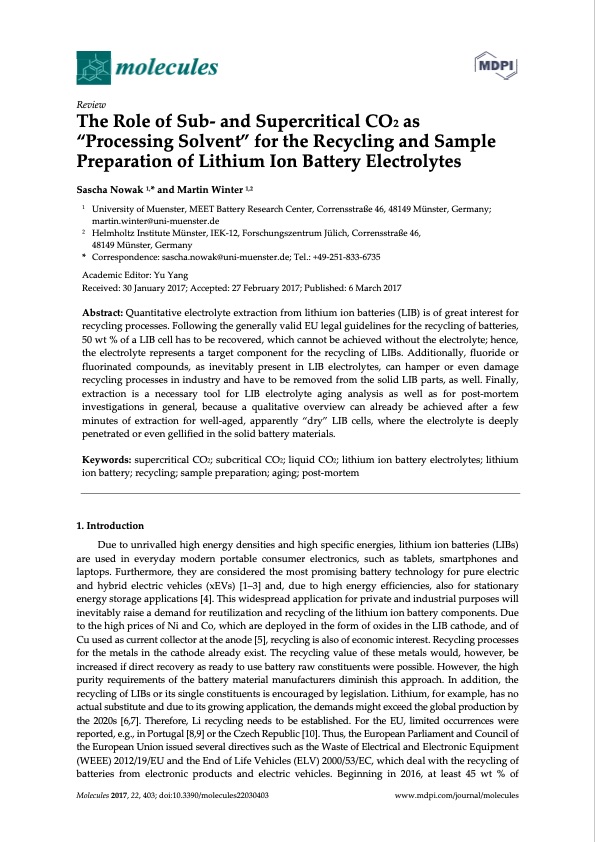
PDF Publication Title:
Text from PDF Page: 002
Review The Role of Sub- and Supercritical CO2 as “Processing Solvent” for the Recycling and Sample Preparation of Lithium Ion Battery Electrolytes Sascha Nowak 1,* and Martin Winter 1,2 1 University of Muenster, MEET Battery Research Center, Corrensstraße 46, 48149 Münster, Germany; martin.winter@uni-muenster.de 2 Helmholtz Institute Münster, IEK-12, Forschungszentrum Jülich, Corrensstraße 46, 48149 Münster, Germany * Correspondence: sascha.nowak@uni-muenster.de; Tel.: +49-251-833-6735 Academic Editor: Yu Yang Received: 30 January 2017; Accepted: 27 February 2017; Published: 6 March 2017 Abstract: Quantitative electrolyte extraction from lithium ion batteries (LIB) is of great interest for recycling processes. Following the generally valid EU legal guidelines for the recycling of batteries, 50 wt % of a LIB cell has to be recovered, which cannot be achieved without the electrolyte; hence, the electrolyte represents a target component for the recycling of LIBs. Additionally, fluoride or fluorinated compounds, as inevitably present in LIB electrolytes, can hamper or even damage recycling processes in industry and have to be removed from the solid LIB parts, as well. Finally, extraction is a necessary tool for LIB electrolyte aging analysis as well as for post-mortem investigations in general, because a qualitative overview can already be achieved after a few minutes of extraction for well-aged, apparently “dry” LIB cells, where the electrolyte is deeply penetrated or even gellified in the solid battery materials. Keywords: supercritical CO2; subcritical CO2; liquid CO2; lithium ion battery electrolytes; lithium ion battery; recycling; sample preparation; aging; post-mortem 1. Introduction Due to unrivalled high energy densities and high specific energies, lithium ion batteries (LIBs) are used in everyday modern portable consumer electronics, such as tablets, smartphones and laptops. Furthermore, they are considered the most promising battery technology for pure electric and hybrid electric vehicles (xEVs) [1–3] and, due to high energy efficiencies, also for stationary energy storage applications [4]. This widespread application for private and industrial purposes will inevitably raise a demand for reutilization and recycling of the lithium ion battery components. Due to the high prices of Ni and Co, which are deployed in the form of oxides in the LIB cathode, and of Cu used as current collector at the anode [5], recycling is also of economic interest. Recycling processes for the metals in the cathode already exist. The recycling value of these metals would, however, be increased if direct recovery as ready to use battery raw constituents were possible. However, the high purity requirements of the battery material manufacturers diminish this approach. In addition, the recycling of LIBs or its single constituents is encouraged by legislation. Lithium, for example, has no actual substitute and due to its growing application, the demands might exceed the global production by the 2020s [6,7]. Therefore, Li recycling needs to be established. For the EU, limited occurrences were reported, e.g., in Portugal [8,9] or the Czech Republic [10]. Thus, the European Parliament and Council of the European Union issued several directives such as the Waste of Electrical and Electronic Equipment (WEEE) 2012/19/EU and the End of Life Vehicles (ELV) 2000/53/EC, which deal with the recycling of batteries from electronic products and electric vehicles. Beginning in 2016, at least 45 wt % of Molecules 2017, 22, 403; doi:10.3390/molecules22030403 www.mdpi.com/journal/moleculesPDF Image | CO2 for Recycling and Sample Preparation of Lithium Ion Battery

PDF Search Title:
CO2 for Recycling and Sample Preparation of Lithium Ion BatteryOriginal File Name Searched:
molecules-22-00403.pdfDIY PDF Search: Google It | Yahoo | Bing
NFT (Non Fungible Token): Buy our tech, design, development or system NFT and become part of our tech NFT network... More Info
IT XR Project Redstone NFT Available for Sale: NFT for high tech turbine design with one part 3D printed counter-rotating energy turbine. Be part of the future with this NFT. Can be bought and sold but only one design NFT exists. Royalties go to the developer (Infinity) to keep enhancing design and applications... More Info
Infinity Turbine IT XR Project Redstone Design: NFT for sale... NFT for high tech turbine design with one part 3D printed counter-rotating energy turbine. Includes all rights to this turbine design, including license for Fluid Handling Block I and II for the turbine assembly and housing. The NFT includes the blueprints (cad/cam), revenue streams, and all future development of the IT XR Project Redstone... More Info
Infinity Turbine ROT Radial Outflow Turbine 24 Design and Worldwide Rights: NFT for sale... NFT for the ROT 24 energy turbine. Be part of the future with this NFT. This design can be bought and sold but only one design NFT exists. You may manufacture the unit, or get the revenues from its sale from Infinity Turbine. Royalties go to the developer (Infinity) to keep enhancing design and applications... More Info
Infinity Supercritical CO2 10 Liter Extractor Design and Worldwide Rights: The Infinity Supercritical 10L CO2 extractor is for botanical oil extraction, which is rich in terpenes and can produce shelf ready full spectrum oil. With over 5 years of development, this industry leader mature extractor machine has been sold since 2015 and is part of many profitable businesses. The process can also be used for electrowinning, e-waste recycling, and lithium battery recycling, gold mining electronic wastes, precious metals. CO2 can also be used in a reverse fuel cell with nafion to make a gas-to-liquids fuel, such as methanol, ethanol and butanol or ethylene. Supercritical CO2 has also been used for treating nafion to make it more effective catalyst. This NFT is for the purchase of worldwide rights which includes the design. More Info
NFT (Non Fungible Token): Buy our tech, design, development or system NFT and become part of our tech NFT network... More Info
Infinity Turbine Products: Special for this month, any plans are $10,000 for complete Cad/Cam blueprints. License is for one build. Try before you buy a production license. May pay by Bitcoin or other Crypto. Products Page... More Info
| CONTACT TEL: 608-238-6001 Email: greg@infinityturbine.com | RSS | AMP |